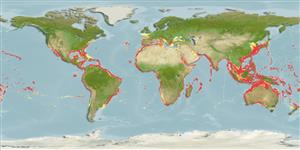Cephalopoda |
Oegopsida |
Pyroteuthidae
Environment: milieu / climate zone / depth range / distribution range
Ecology
Pelagic; depth range 1 - 600 m (Ref. 275). Tropical; 50°N - 40°S, 180°W - 180°E (Ref. 275)
Circumglobal from temperate to tropical climates and the Mediterranean Sea.
Length at first maturity / Size / Weight / Age
Maturity: Lm ? range ? - ? cm Max length : 4.0 cm ML male/unsexed; (Ref. 104052)
Maximum depth from Ref. 110525. A cosmopolitan in tropical to subtropical oceanic waters. Mesopelagic to about 500 m and ascends to the surface and epipelagic zone at night. Undertakes diel vertical migrations: off Bermuda, at 250 to 500 m by day and 50 to 250 m at night. Off Hawaii it is a facultative inhabitant of the mesopelagic boundary zone. Preyed upon by large dolphins (e.g. Tursiops truncatus) and pelagic fishes (Ref. 97142).
Life cycle and mating behavior
Maturity | Reproduction | Spawning | Eggs | Fecundity | Larvae
Members of the class Cephalopoda are gonochoric. Male and female adults usually die shortly after spawning and brooding, respectively. Mating behavior: Males perform various displays to attract potential females for copulation. During copulation, male grasp the female and inserts the hectocotylus into the female's mantle cavity where fertilization usually occurs. Life cycle: Embryos hatch into planktonic stage and live for some time before they grow larger and take up a benthic existence as adults.
Roper, C.F.E., M.J. Sweeney and C.E. Nauen. 1984. (Ref. 275)
IUCN Red List Status (Ref. 130435)
CITES status (Ref. 108899)
Not Evaluated
Not Evaluated
Threat to humans
Harmless
Human uses
Fisheries: of no interest
| FishSource |
Tools
More information
Age/SizeGrowthLength-weightLength-lengthMorphologyLarvaeAbundance
Internet sources
Estimates based on models
Preferred temperature
(Ref.
115969): 12.2 - 26.3, mean 18.1 (based on 1608 cells).
Vulnerability
Low vulnerability (10 of 100).
